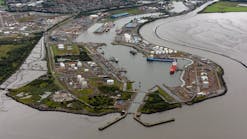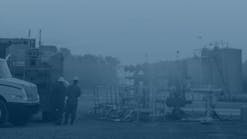The oil industry has long been aware of the potential dangers of static electricity in the storage and movement of petroleum products. If this phenomenon caused the downing of TWA Flight 800 off Long Island, N.Y., last summer, Stanford University Professor Emeritus Sullivan S. Marsden Jr. believes simple techniques used by the oil industry to prevent explosions and fires may be useful in averting such air disasters.
In the early years of the petroleum industry, explosions during pumping operations were fairly common. Research into the phenomenon began, in earnest, in the 1950s, Marsden told Oil & Gas Journal.
"It was quickly recognized that this behavior was due to a phenomenon well known in the scientific community as electrostatics or 'streaming potential,'" said Marsden. His explanation of the phenomenon is as follows:
"Streaming potentials occur when a liquid containing charged particles, such as ions, is pumped through a tube or pipe made of an electrically insulating material [rubber or plastic]. Some of the charged particles flow more readily than other, oppositely charged particles because the latter are stuck to the wall of the tube by...adsorption.
"The flow of the charged particles constitutes a kind of electric current, and an electrical potential is built up between the inlet and the outlet of the tube."
If the liquid conducts electricity, current flows in the direction opposite of the "streaming" current, says Marsden, and charge does not build up. If the liquid is a poor conductor of electricity, as are most petroleum products, a voltage builds between the two ends of the pipe.
"This potential can amount to thousands of volts," said Marsden, "and can result in a static electricity discharge, or spark."
In the presence of explosive vapors and air, this discharge can cause an explosion or fire -- a fact, Marsden says, that has been demonstrated in the laboratory.
Media reports on TWA Flight 800 have indicated that the transfer of jet fuel from the airplane's main fuel tank to wing tanks may have initiated an explosion.
"While electrostatics and streaming potential are well known by some in the petroleum industry," said Marsden, "the phenomenon is apparently unknown in the aeronautical industry. The pumping of jet fuel through rubber or plastic pipes...could have generated an electrostatic potential which could supply an ingniting spark."
Prevention
In the oil industry, all storage system components are electrically grounded, says Marsden. And, where use of flexible plastic or rubber tubes is necessary, metallic wire is built into the tubes.
"Also, materials have been found which are both soluble in hydrocarbon liquids in small amounts and also increase the electrical conductivity of these liquids significantly. This diminishes the electrostatic potential generated as the streaming potential," says Marsden.
Marsden says several factors would have to be present simultaneously in order for this phenomenon to cause an airplane to crash. For a 25-year-old plane such as the one involved in this incident:
- Rubber or plastic tubing would have to be present (probably added during maintenance of the aircraft)
- The jet fuel in the tanks must have lacked conductivity additives.
Marsden believes the oil industry might be able to provide insight into the factors that should be investigated to determine if electrostatics played a role in this incident.
Copyright 1997 Oil & Gas Journal. All Rights Reserved.


